- Prelude
- Editorial
- A Conversation with Sheela Gowda
- The DIY Artist with a Mission
- Discovering Novel Horizons
- A Conversation with Raqs Media Collective
- Manjunath Kamath
- Jitish Kallat- the Alchemist
- The Artist and the Dangers of the Everyday: Medium, Perception and Meaning in Shilpa Gupta's work
- An Attitude for the Indian New Media
- Weave a Dream-Theme Over Air or a Medium like Ether
- Installation in Perspective: Two Outdoor Projects
- Towards The Future: New Media Practice at Kala Bhavana
- Workshop @ Facebook
- Desire Machine: Creating Their Own Moments…
- Typography: The Art of Playing with Words
- Legend of a Maverick
- Dunhill-Namiki
- The Period of Transition: William and Mary Style
- The Beauty of Stone
- Nero's Guests: Voicing Protest Against Peasant's Suicides
- Patrons and Artists
- The Dragon Masters
- What Happened and What's Forthcoming
- Art Chennai
- Art Events Kolkata
- Winds of Change
- Art Bengaluru
- Mumbai Art Sighting
- Musings from Chennai
- In the News
- Previews
- Ascending Energy, Merging Forms: Works by Satish Gujral
- Re-visiting the Root
- The Presence of Past a New Media Workshop
- Taue Project
ART news & views
The Beauty of Stone
Volume: 3 Issue No: 15 Month: 4 Year: 2011
Antique
by Wong Tsz Mei
Jade is a stone; in fact crystal, jadeite, ruby, sapphire, etc are all stones. They are deemed as precious stones and they stand out from other kind of stones for their excellent quality, the unique beauty which give them that position. Whether it is jade or any other precious stone, they all have alluring colour and luster comparable to that of gold. 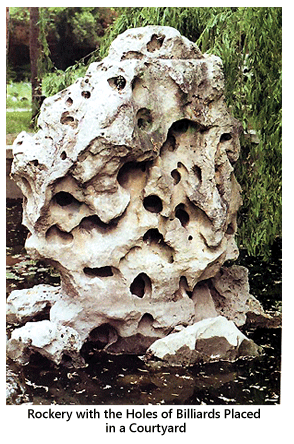 Therefore the desire of wearing precious stones to enhance one's beauty is evoked. They are categorized as jewellry and are treasured up for fear of damaging it. We tend to overlook some stones which candidly expose themselves in the wide- open area and undergo the endless erosion, severe test of rain and wind. All the effeminacy and luxury are scaled off and the austere spirit manifests. This is a kind of natural wonder which is beyond the creation of manpower.
Therefore the desire of wearing precious stones to enhance one's beauty is evoked. They are categorized as jewellry and are treasured up for fear of damaging it. We tend to overlook some stones which candidly expose themselves in the wide- open area and undergo the endless erosion, severe test of rain and wind. All the effeminacy and luxury are scaled off and the austere spirit manifests. This is a kind of natural wonder which is beyond the creation of manpower.
People who like to collect such kind of natural wonder mostly love the eroded stones produced from the provinces of Tai Woo county and Yingde county in China. These stones lie under water near the waterfront and so the quarry workers have to dive in the water to chisel the stones of grotesque shapes with their iron hammers and chisels. If the stones are really big, it is bundled up with thick ropes and winched out of water by the apparatuses installed on ships. This type of stones, have criss-cross grains all over their bodies. Because of the swash of stormy waves their surface is covered with a lot of concave holes, and so they are named as “the holes of billiards”. The large rocks are chosen as rockeries and placed in courtyards or gardens allowing some majestic feeling to the charming sight. As for the small rocks, they are placed on the teapots or used to decorate the bonsai. Whether it is rockery or intricate stone, it should have a proclivity of vicissitudinous charges and then would suit the taste for particular appreciation. If some art virtuoso ever heard that somewhere a famous garden fell into disuse and had some old rockeries for sale, or they noticed some stones bearing the inscriptions of some celebrities being brought to market; they would offer a high price to buy it. In fact, such kind of stones are the same as that in the mountains or in the wild, for they are exposed to the weather in the same way. As there is no difference among the stones, then why should we separate the old from the new?
What are the criteria used to judge the quality of the stones for appreciation? Ancient stone evaluative terminologies are: 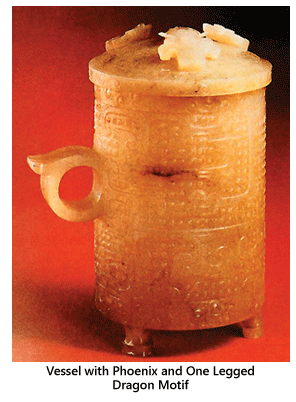 penetrate, thin, wrinkled, leakage, ugly, stubborn, and clumsy. Judging from the adjectives, the traits of the rockery are insulated with the elegant, splendid ambiances, and we also do not want to be linked with such descriptions. This is something out of the compass of human power, and should be ascribed to the extremely fine craftsmanship of Mother Nature. Man with the superiority of its own wits established the modern world invested with our form of values, we habitually thinking, planning and pursuing the goal in life according to the established orientation. We are accustomed to the complacencies of the pursuit of well being and blissfulness, being under the impression that we are the ruler of the existing world. Only when nature brings its mightiness into full play, destroying our constructions and paralyzing our transportations, we realize who truly is the master. Those wrinkled thin rockery, ugly clumsy stone is the masterpiece of nature that finished it effortlessly. Thus masterpiece is a microcosm of the real circumstances outside our comfort zone. Placing it in our own created little world, the meteorology of nature is led into our living environment.
penetrate, thin, wrinkled, leakage, ugly, stubborn, and clumsy. Judging from the adjectives, the traits of the rockery are insulated with the elegant, splendid ambiances, and we also do not want to be linked with such descriptions. This is something out of the compass of human power, and should be ascribed to the extremely fine craftsmanship of Mother Nature. Man with the superiority of its own wits established the modern world invested with our form of values, we habitually thinking, planning and pursuing the goal in life according to the established orientation. We are accustomed to the complacencies of the pursuit of well being and blissfulness, being under the impression that we are the ruler of the existing world. Only when nature brings its mightiness into full play, destroying our constructions and paralyzing our transportations, we realize who truly is the master. Those wrinkled thin rockery, ugly clumsy stone is the masterpiece of nature that finished it effortlessly. Thus masterpiece is a microcosm of the real circumstances outside our comfort zone. Placing it in our own created little world, the meteorology of nature is led into our living environment.
The stone collectors besides knowing how to choose stones should also know how to arrange them. Some stones should be placed on ebony pedestals, some rocks should be put in a container with water which should not be misplaced. Moreover, the ebony pedestal with stone should be put on a small table adjacent to a bright window; while the stone in basin should be placed at the winding balustrade. To speak of the stones of bonsai, only those showing stratiform resembling the folds of mountains could manifest the momentum of nature; what is more important is that the set-up of the bonsai should also be attentive. The flowers and plants growing on the stratified rockery should be compact with vigorous branches, and furthermore even a small spot of moss, a little stem of grass should also be laid out meticulously. With all these elaborations facing the bonsai, our ideological levels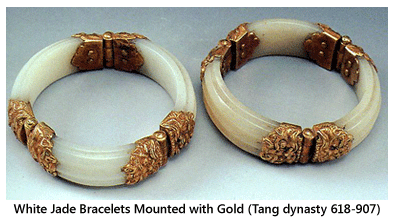 transcending the boundaries of the physical environment, get into contact with the vast, boundless space thousand miles away.
transcending the boundaries of the physical environment, get into contact with the vast, boundless space thousand miles away.
Therefore not only the glittering stones of the quintessence of Mother Earth are valuable, but those recorded the vestige of ancient history with the leakages and sores are also priceless. The long distant past, the time scale over which unpredictable changes occurred in matters left them retaining some indefinite denude.
Ancients had a saying: the millenary turpentine dropped into the ground and turned into amber. It is also said that: in the thousands of years ice is changed into crystal. It is a metaphor about the spotless beauty of the unflawed limpidity of ice analogous to that of crystal. Such glacial beauty as a goddess of north land, coupled with the remote indistinctness, seems having an aura of mystery. No wonder the mediums would use crystals as a vehicle to communicate with the unknown territories. Referring to practicality, in China, during the Stone Age tools were made of crystals, which have been produced at many places, almost in all provinces, in China. The rough classification of crystals is “the southern white and the northern black”. The southern part of China produces clear, colourless stones which are hard and shiny as glass; the northern part of China produces crystals that are black in colour. Some crystals are purple due to the presence of manganese; when citrine is present the colour is dark brown. Furthermore, the crystal that mixes with other kind of stones, cross- grained is popularly called “haired crystal”, and the coarse-grained is named “bristle crystal”. All the above mentioned are the main types of crystal which are common and ancient gems. China is a vast territory with abundant resource, which produces many kind of stones with different temperaments, 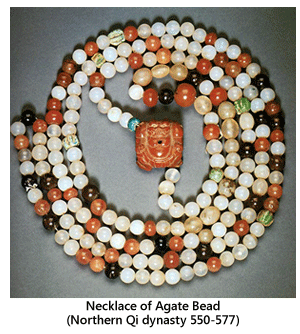 but only one kind of stone can consubstantiate with human body as an organic whole; only jade is deemed having the affinitive nature with human.
but only one kind of stone can consubstantiate with human body as an organic whole; only jade is deemed having the affinitive nature with human.
One of the reasons behind this affinity is that jade is moderate in temperament with mild body temperature. It is suitable for wearing all the year round as compared with other precious stones some of which should be worn only in summer, and especially not in winter. Other stones are cold nature with the indistinguishable biting chill which could harm the health of the wearer. The innate sleek and warm character is the inherent virtue of jade. Such properties of jade could better the blood circulation of human body, could milden our nature and that is why the ancient people wore jades all the time. The other precious jewellry attracts people's attention by its glaring luminosity. Ancients thought that such splendours were the remaining internal heat skimming over the surfaces of the stones, and such light is pleasing to the eye, not to the heart. The glory of ancient jade being latent within is a kind of solemn and quiet aura assimilating with the awe-inspiring bearing restrained inside of a sage who preformed an accommodating manner. Therefore the integrity of jade is much more superior to the general stones ten million times.
The photo shows a cup shaped container with the height of 12.3cm, carved and polished from a jade. This is an antique of Han dynasty (from BC 206 to AD 220). From its partial erosion with brown and purple colour, we can see that it is an unearthed relic, not being handed down from generation to generation. This was originally a treasure from the collection of the Qing court; now in the possession of the Palace Museum. It is a wine container named Vessel with Phoenix and One-legged Dragon Motif. Mostly, the unearthed jades were furnishings and accessories, so it is rare to excavate a whole piece of jade carved in the shape of an utensil. Moreover, both the body and lid of the vessel without damage were skilfully and delicately carved the low relief of the variant dragon and phoenix pattern, contrasting with the three-dimensional sheep heads' carving which symbolizes good luck. The handle of the vessel is cloud-shaped and the bottom is three beast's leg. The whole vessel is a combined craftsmanship of sculpture, relief and linear engraving. It embodied pristine and sprightly beauty, which was constituted in a harmonious whole. It is a national heirloom for there is no other one in China. Furthermore, the finishing touch on the translucent aura of mystery by the hand of human, with the earthly flavour of it's being excavated from underground; consequently, there is certain inwardness between human and jade. They are interrelated and interacted with each other.
Therefore the ancients thought that jade is a living material and have strong affinity with human. When jade is buried in the earth, it would absorb the immediate elements into its body. Then the action of acidification in its body occurs, and after a considerable period of time leads to the loss of its own properties. There is a saying from the past: The buried jade, in the course of one thousand years, its quality is similar to stone; after two thousand years, its appearance is associable with decayed bone; and after six thousand years without excavation, it would decompose as mud. However no matter how rotten the jade is, as long as being unearthed, in the caress of human hand, the character of jade would gradually recover. 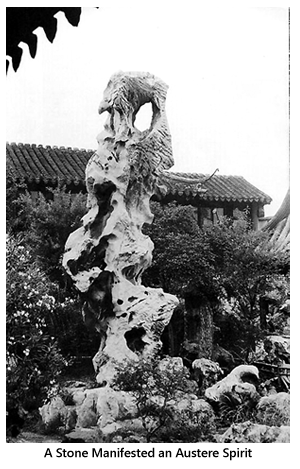 When the jade comes to life again, it would clear the differentiated matters out of its body, or would melt the absorbents into its veins, and then produce a kind of pulp to fill in the gaps. As a result, the original colour of jade changes, and beautiful patterns appear. Undergoing such noticeable transformation in its appearance, the whole body of the jade becomes even glossier, much more glittering and translucent, coruscating extraordinary splendour. In the past, such action of transformation was named as “casting off one's old self”, which in a certain sense is quite similar to the transfiguration of a mortal who thoroughly remould oneself and is reborn as a celestial being.
When the jade comes to life again, it would clear the differentiated matters out of its body, or would melt the absorbents into its veins, and then produce a kind of pulp to fill in the gaps. As a result, the original colour of jade changes, and beautiful patterns appear. Undergoing such noticeable transformation in its appearance, the whole body of the jade becomes even glossier, much more glittering and translucent, coruscating extraordinary splendour. In the past, such action of transformation was named as “casting off one's old self”, which in a certain sense is quite similar to the transfiguration of a mortal who thoroughly remould oneself and is reborn as a celestial being.
Therefore nothing could rival the sublime status of jade in ancient China, and the extent of using jade in daily life was vast: from the important affairs of state, such as sacrificial rites, grand ceremonies, royal engagements, seals for emperors, etc., to folkways and civil life, for instance, betrothal gifts, study apparatuses, accessories, tableware, wine containers, even the ornaments of houses and chariots. Jade had blended in every aspects of life far back in history and could be considered as the prevailing custom for a given time. Therefore at that time wearing jade was a necessity for gentlemen and they would not take off the jade ornaments without reason. Besides, the close affiliation of jade and human was personified as an affinity between oneself and the Sage whose virtuous spirit redolent of pristine ideals would always remind us of the continuing efforts for inner cultivation. By making unremitting efforts, we would someday turn into a Sage. Nowadays, even in this modern world, most people adore its flashy beauty, and few people have a strong admiration for the inner beauty of this pristine stone as well.